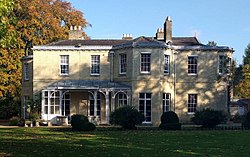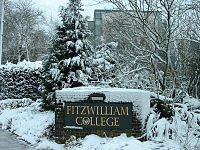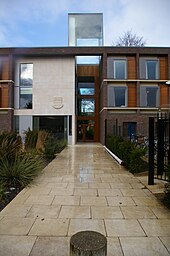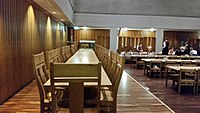Difference between revisions of "Fitzwilliam College, Cambridge"
(Created page with "{{Infobox college |name=Fitzwilliam College |county=Cambridgeshire |university=Cambridge |city=Cambridge |picture=The Grove at Fitzwilliam College, Cambridge 2017.jpg |picture...") |
(No difference)
|
Latest revision as of 22:23, 31 March 2024
| Fitzwilliam College
| |||||||||||
|
Ex antiquis et novissimis optima | |||||||||||
|---|---|---|---|---|---|---|---|---|---|---|---|
 The Grove, Fitzwilliam College | |||||||||||
| Master: | Baroness Morgan of Huyton | ||||||||||
| Website: | www.fitz.cam.ac.uk | ||||||||||
| |||||||||||
| Location | |||||||||||
| Grid reference: | TL43905945 | ||||||||||
| Location: | 52°12’52"N, 0°6’18"E | ||||||||||
Fitzwilliam College is a constituent college of the University of Cambridge.
The college traces its origins back to 1869 and the foundation of the Non-Collegiate Students Board, a venture intended to offer academically excellent students of all backgrounds a chance to study at the university. The institution was originally based at Fitzwilliam Hall (later renamed Fitzwilliam House), opposite the Fitzwilliam Museum in south-western Cambridge. Having moved to its present site in the north of the city, Fitzwilliam attained collegiate status in 1966. Female undergraduates were first admitted in 1978, around the time most colleges were first admitting women.
Fitzwilliam is now home to around 500 undergraduates, 400 graduate students and 90 fellows.[1] By overall student numbers, it was the seventh-largest college in Cambridge as of 2018/19.
Contents
History
Foundation
In 1869, Cambridge University altered its statutes to allow men who were not members of a college to become members of the university under the supervision of a censor, whose office was in Trumpington Street, opposite the Fitzwilliam Museum, founded in 1816 under the will of Richard FitzWilliam, 7th Viscount FitzWilliam (1745–1816). This provided students who could not afford to belong to a college with a base from which to study at the university, allowing them to be admitted to degrees, sit examinations and compete for scholarships.[2] The name "Fitzwilliam" was chosen by the students at a meeting of the Non-Collegiate Amalgamation Club in 1887 and, as a result, the university decreed that the house in Trumpington Street could be known as Fitzwilliam Hall. The coat of arms of the new establishment appropriated the arms of the Fitzwilliam family (lozengy argent and gules), to which it had no connection, and added as a chief the arms of Cambridge University. Fitzwilliam Hall became the headquarters of the Non-Collegiate Students Board and provided student facilities and limited accommodation. It was renamed Fitzwilliam House in 1922.
Due to its emphasis on academic ability rather than wealth, Fitzwilliam quickly attracted a strong academic contingent that included future Nobel Prize winners, Heads of State and important judicial figures. It developed a tradition in Medicine and established a reputation as one of the most internationally diverse institutions within the university.[3]
In the second half of the 20th century, the availability of grants made Cambridge more accessible and the need for a non-collegiate body of undergraduates began to decline. The suggestion that Fitzwilliam close prompted an outcry from former students and it was therefore decided that it should aim for collegiate status. Funds were accumulated and a new site was acquired at Castle Hill, about one mile north of the city centre. The first new buildings were opened in 1963.
In 1966, Fitzwilliam House was granted a royal charter and became Fitzwilliam College.[2]
Expansion
Since Fitzwilliam began operating at its current site in the north-west of Cambridge, it has grown steadily and developed into one of the university's larger, more cosmopolitan colleges. Built around a regency manor house, the college has grown by one or two buildings each decade and now consists of five interconnected courts, enclosing large, rectangular gardens.[4] In contrast to most of the university, and indeed the regency estate at the college's centre, the majority of the buildings are of modern design.[5]
The first two courts and the central building (comprising, among other things, the rooms formerly belonging to the old library, the dining hall, the junior common room and the bar) were designed by Sir Denys Lasdun] and completed in 1963. The intention was for these buildings to constitute the back of the college and, as funding became available, the college grew to the south, with New Court (1985), the Chapel (1991) and Wilson Court (1994). Finally, the plan was completed when Gatehouse Court (2003) became the college's new front. In the following year, the college completed the new Auditorium building, and in doing so became home to some of the best performance facilities in the university.[6]
In 2007 the college built a new boathouse on the River Cam, in 2009 the Library and IT Centre was added and, in 2010, the college acquired the buildings and grounds that formerly belonged to the Cambridge Lodge Hotel with the intention of renovating them for the use of graduate students.
Fitzwilliam has, over the years, also become known for its beautiful gardens, which largely predate the college.[7] In 2008, an archaeological dig discovered on the college site the earliest clear evidence of settlement in Cambridge, the remains of a 3,500-year-old farmstead.[8]
Buildings and grounds
The main grounds of the college are located off Storey's Way, towards the north-west of Cambridge. The college is sometimes identified as one of the 'Hill Colleges', together with Churchill College, St Edmund's College, Girton College and Murray Edwards College. These colleges are all among the most recently established and tend to share certain architectural features.
Fitzwilliam consists of a variety of modern buildings, built in the grounds of a regency estate.
The Grove (1813)
The college's centrepiece is the Grove, a Grade II regency manor house, designed by the architect William Custance and constructed in 1813. Custance was also the house's first resident and his initials, along with the date '1814', can be found on a rainwater hopper at the side of the house.[9]
Another slightly smaller building known as Grove Lodge was also designed by Custance and is now part of Murray Edwards College.[10] For some time, both properties were owned by the Darwin family and the Grove served as Emma Darwin's primary residence between 1883 and 1896, following the death of her husband Charles. During this time, she had the interior lined with original William Morris wallpaper and two of her sons had smaller houses built in the grounds. Although both have since been demolished, the house built by Horace Darwin, which was known as the Orchard, was donated to Murray Edwards College in 1962 and the site now serves as its primary campus.[11] In 1988, the Grove became part of Fitzwilliam and today it is home to the Senior Tutor's office and various multi-purpose rooms, as well as the Middle and Senior Common Rooms.[9]
The Hall Building (1963)
The Hall Building is a large complex towards the back of the college. It was built between 1960 and 1963 and was designed by Sir Denys Lasdun, who won Royal Gold Medal in 1977 and is best known for having designed the National Theatre in London.[12] The building consists primarily of the college dining hall, but also houses the bar, kitchens, the junior common room, a couple of seminar rooms and a music room. The dinner gong, just outside the dining hall, was originally the bell of the aircraft carrier HMS Ocean, and was presented to Fitzwilliam House by Admiral of the Fleet Sir Caspar John in 1962.[13]
Fellows' Court (1963)
Like the Hall Building, Fellows' Court was part of the initial construction, designed by Sir Denys Lasdun and completed in 1963 at a cost of approximately £300,000.[14] It occupies an area in the far corner of the college and is enclosed by the Hall Building, the Law Library and two dormitories. It is generally reserved for fellows, and, as well as residence, housed the Fellows' Parlour.
Tree Court (1963)
Tree Court, the last component of the initial 1963 construction, is located at the north end of the college, opposite Fellows' Court. The court was initially the college's main entrance and, with a car park and a cycling bay just outside, it remains a back door to the college. Tree Court was Lasdun's first student accommodation; he would go on to design similar buildings at the University of East Anglia and Christ's College, Cambridge.[15] Although the court opens out onto the college gardens, the wall opposite the Hall Building was recently lengthened with the addition of the college's new Library and IT Centre. Today, Tree Court provides residence for the majority of first-year students.
New Court (1985)
In the mid-eighties, the college expanded to the south with the construction of New Court, a three-walled residential compound, designed by MacCormac Jamieson Prichard. Students and fellows contributed to the design with such ideas as intersecting staircases and elongated windows.[16] The building won 1989 David Urwin Award for Best New Building.
In 2004, the court gained its fourth wall with the completion of the college's new auditorium.
The Chapel (1991)
In 1991, a college chapel was appended to the north wing of New Court. The building, which was also designed by MacCormac Jamieson Prichard, faces directly towards the Grove and is in the International style. It is designed to resemble the hull of a ship, hinting at the religious themes of journey and protection. The building is home to a fine two-manual organ designed by Peter Collins, a Bechstein grand piano and a Robert Goble|Goble harpsichord.[17]
The Olisa Library (2009)
A new library and IT centre was completed in 2009. As of January 2010, its book collection contains around 60,000 volumes and increases by about 1,000 volumes each year.[18] In 2011, alumnus Ken Olisa donated £1.4 million to the development of the Library and IT Centre. In tribute to this generosity, the building was named the Olisa Library. Unlike most college libraries, it is open 24 hours a day and 7 days a week.
Because Fitzwilliam is at the top of one of the few hills in Cambridge, the Olisa Library's tower is one of the highest points in the city, sometimes said to be the highest.[19]
Name
The name of the college refers ultimately to the Fitzwilliam family, prominent members of the Anglo-Irish nobility, whose ancestral seat Milton Hall is located to the north of Cambridge and who, as students and benefactors, have been associated with the university for several hundred years; more directly, it refers to the Fitzwilliam Museum, founded in 1816 with the bequest of the library, art collection and personal fortune of the 7th Viscount Fitzwilliam and situated directly opposite the original headquarters of the Non-Collegiate Students Board, and also to the adjacent Fitzwilliam Street, where many of the non-collegiate students were housed.
Outside links
| ("Wikimedia Commons" has material about Fitzwilliam College, Cambridge) |
References
- ↑ "People". Fitzwilliam College. 2014. http://www.fitz.cam.ac.uk/about/people.
- ↑ 2.0 2.1 "Fitzwilliam College Heritage". Fitzwilliam College. 2010. http://www.fitz.cam.ac.uk/about/heritage.
- ↑ "Cambridge University Colleges". University of Cambridge. 2009. http://www.cam.ac.uk/admissions/undergraduate/colleges/fitzwilliam/.
- ↑ "Fitzwilliam College Map". Fitzwilliam College. 2010. http://www.fitz.cam.ac.uk/about/map-of-college.
- ↑ "Fitzwilliam College Architecture". Fitzwilliam College. 2010. http://www.fitz.cam.ac.uk/about/heritage/architecture.
- ↑ "Fitzwilliam College Auditorium". Fitzwilliam College. 2010. http://www.fitz.cam.ac.uk/about/heritage/architecture/auditorium.
- ↑ "Fitzwilliam College Gardens". Fitzwilliam College. 2010. http://www.fitz.cam.ac.uk/about/heritage/gardens.
- ↑ "Bronze Age site is found in city". BBC News. 17 January 2008. http://news.bbc.co.uk/1/hi/england/cambridgeshire/7194650.stm.
- ↑ 9.0 9.1 "Fitzwilliam College's The Grove". Fitzwilliam College. 2010. http://www.fitz.cam.ac.uk/about/heritage/architecture/the-grove.
- ↑ "Grove Lodge Profile". Cambridge 2000 Project. 2000. http://www.cambridge2000.com/cambridge2000/html/addendum/P31310653.html.
- ↑ "Murray Edwards College History". Murray Edwards College. 2009. http://www.murrayedwards.cam.ac.uk/about/history/briefhistory/.
- ↑ Rowntree, Diana (12 January 2001). "Sir Denys Lasdun Obituary". The Guardian (London). https://www.theguardian.com/news/2001/jan/12/guardianobituaries.
- ↑ "Hall Building – Fitzwilliam College". University of Cambridge. 2010. http://www.arct.cam.ac.uk/UCPB/PlaceEx.aspx?p=6&ix=438&pid=17&prcid=27&ppid=218.Template:Dead link
- ↑ "Fitzwilliam College's Core Site". Fitzwilliam College. 2010. http://www.fitz.cam.ac.uk/about/heritage/architecture/hall-building.
- ↑ "The Works of Sir Denys Lasdun". ArchINFORM. 2001. http://eng.archinform.net/arch/767.htm.
- ↑ "Fitzwilliam College's New Court". Fitzwilliam College. 2010. http://www.fitz.cam.ac.uk/about/heritage/architecture/new-court.
- ↑ "Fitzwilliam College Music Facilities". Fitzwilliam College. 2010. http://www.fitz.cam.ac.uk/music/facilities.
- ↑ "Fitzwilliam College Library". Fitzwilliam College. 2010. http://www.fitz.cam.ac.uk/library.
- ↑ "50 Fitz Facts". Fitzwilliam College. 2016. http://www.fitz.cam.ac.uk/about/fifty-years-college/50fitzfacts.
| Colleges of the University of Cambridge | |
|---|---|
|
Christ’s • Churchill • Clare • Clare Hall • Corpus Christi • Darwin • Downing • Emmanuel • Fitzwilliam • Girton • Gonville and Caius • Homerton • Hughes Hall • Jesus • King’s • Lucy Cavendish • Magdalene • Murray Edwards • Newnham • Pembroke • Peterhouse • Queens’ • Robinson • St Catharine’s • St Edmund’s • St John’s • Selwyn • Sidney Sussex • Trinity • Trinity Hall • Wolfson |
|










